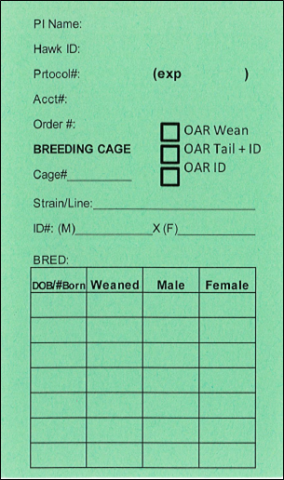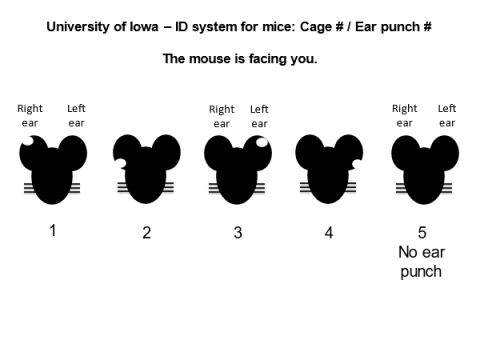Rodent Breeding Colony Management
***All breeding animals in the same cage must be under the same approved animal protocol number (AP) for which the breeding is intended for. This may require a "transfer" transaction slip being completed and processed before breeders are set up.***
- Upon request, OAR will train research staff how to manage their breeding colonies:
- Setting up breeding pairs
- Weaning
- ID system
- Tail snips
- Male rodents should never be combined for housing
- Exception: littermates that were always housed together and not used for breeding may remain housed together
- For more details refer to the Policy on Housing of Social Species
Cage cards required in a breeder cage
- A completed standard white cage card is needed for each animal
- White card

- A complete green breeder card must be placed in any cage where a litter may be born/expected
- Examples of conditions where a litter may be born/expected include
- Time pregnant dams
- Mis-sexed cage
- Sentinel dams in quarantine rooms
- Recipient dams via embryo transfer
- The green breeder card follows the female if she is removed from the cage
- Examples of conditions where a litter may be born/expected include
-
- Breeder card

Procedure for paired breeding
- House one male mouse with one female house (a pair) in a clean cage
- Assure access to food and water
- Cage cards
- Male
- Must have a completed standard white cage card
- Female
- Must have a completed standard white cage card
- Must have a completed green breeder card
- Male
Procedure for harem breeding
- Set-up one male mouse with up to three female mice in a cage
- Cage cards
- Each female
- Must have a completed standard white cage card
- Must have a completed green breeder card
- Male
- Must have a completed standard white cage card
- Male may be rotated among the females that were separated (set up in clean cage) for future breeding
- Each female
- Required separation of animals
- No more than two adults and one litter may be present in a mouse breeder cage at once
- Each female housed in a harem must be separated into her own cage (by laboratory staff) once it shows signs of pregnancy
- Separation of the pregnant dam must occur to maintain cage space requirements1 prior to delivery of the litter
- Cage cards must move with the animals
- Female: the green breeder card and the white cage card must move with her when separated
- Male: the white cage card must move with the male when he is placed in a different cage
Procedures for weaning
- What is weaning?
- Weaning is the act of separating the young mice/rats into their own cage at a time where they are ready and able to live on their own
- Rodent litters must be weaned at day 21 +/- 3 days (18-24 days) post birth
- Procure new cages (filter top, food hopper/wire bars and cage bottoms)
- Add feed to the cage and verify that the water valve is working properly
- Additional details on rodent weaning procedures may be found in the OAR Information Sheet: New Weanling Procedure for Labs
- Assure you have generated additional white cage cards to identify the animals that will be weaned
- Correctly enter the investigator, hawkID, animal protocol, account, date of birth, sex, and umber of mice per cage, contact staff and additional identifying information as requested/necessary
-
- An individual white card (one card per rodent), is not necessary/mandatory; these individual cards may be generated at the discretion of the lab
- Separate rodents by sex
- No more than 5 non-breeding mice may be housed per cage
- This may vary based on mouse size/strain and research use
- See an OAR facility supervisor for further information
- Each cage of weanlings must have a completed standard white cage card
- This may vary based on mouse size/strain and research use
Collection of genetic material for Genotyping
- Tissue for genetic analysis is routinely collected at weaning age to verify the genetic composition of an animal
- Collection of tissues for genetic analysis must be approved in the animal protocol
- Refer to the Policy on Genotyping- Rodent Tail Snipping for Genotyping and Policy on Genotyping – Mouse Toe Clipping for instructions and expectations when conducting these procedures
OAR Breeder Informational Cards

- Please refer to the following link for details about conditions associated with breeding practices that will generate charges to an investigator
OAR Rodent Breeding Colony Management - Fee for Service
- OAR can offer management of breeding colonies (must be approved by OAR) for a fee. Fee structures may be found here.
OAR’s cage and ear punch identification system
- OAR has adopted a simple rodent identification system.
- This system is used when OAR husbandry and/or veterinary staff assist in identifying rodents (fee for service)
- Each cage of animals is given a number
- Each cage of animals will start with ear punch #1
- No animal is assigned an ID # higher than 5 as this is the maximum number of weaned animals that may be housed in a cage

References
-
- Guide for the Care and Use of Laboratory Animals: Eighth Edition. Washington, DC: The National Academies Press. https://doi.org/10.17226/12910.